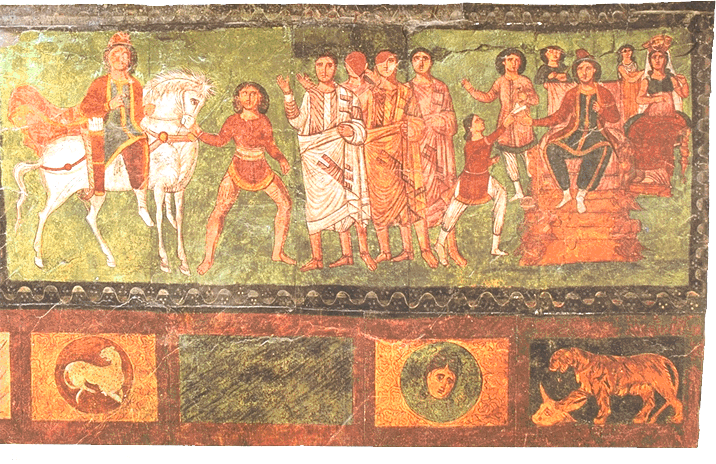
======================================

by Guy Shaked
In the 1920’s and 1930’s there were held excavations at the site of the ancient city of Dura Europos in Syria. These excavations revealed in 1932 among other finds an ancient Jewish synagogue whose walls were covered with colored wall paintings depicting scenes from the Hebrew bible.
The synagogue belonged to the Jewish community who lived in this city and maintained connections with the Babylonian Jewry. It was buried underground and preserved thus, thanks to the Roman Persian wars during the third century AD. This is because the Romans, covered the area, creating an earth rampart, during their preparations for a Persian siege.
The city of Dura Europos, was founded during the third century BC, by the Seleucides. It was known at ancient times as Dura – the fortress, and stands at the eastern desert of Syria. By the first century BC it became part of the Parthian empire. In the 160’s AD it was captured by the Romans and in the 250’s was occupied by the Sasanid (Persian) empire.
The discovery of the synagogue wall paintings was described by Clark Hopkins:
“I clearly remember when the foot of fill dirt still covering the back wall was undercut and fell away, exposing the most amazing succession of paintings. Whole scenes, figures and objects burst into view, brilliant in colour, magnificent in the sunshine”.
Among the paintings of the walls of the synagogue there is one depicting the scroll of Esther. This was thought to represent the festivities of the annulment of the decree to exterminate the Jew.
According to this view, on the left of the painting is depicted Mordecai the Jew who was seated on a horse and paraded in town for all people to pay respect to him (Esther 6:6-11). On the right of the painting there is the same Mordecai, sending orders (written) for the annulment of the decree to exterminate the Jews of the Persian empire (Esther 8:2-14).
Yet, the painting could be perceived to represent not only the festivities of the annulment of the decree to exterminate the Jews but also the actions of the issuing of those same decree.
According to such a view, on the left there is Haman the minister to the king mounted on a horse (while the bible does not mention this specifically it is most likely that Haman used a horse as a means of transportation for someone in his status) with the people he encountered ordered to bow before him, yet Mordecai wouldn’t bow (Esther 3:1-3). On the right, there is Haman, sending the addict for the extermination of the Jews of the Kingdom (Esther 3:9-14).
It appears therefore that the painting of the scroll of Esther builds on the parallel (mirror like) structure of the text and is ambiguous on who the main character depicted is. The main figure of the painting is both Mordecai the Jew and his arch-enemy Haman the minister to the king. The issuing the decree to exterminate the Jews and the honor paid to Haman are seen as allegorical and parallel to the issuing the decree for the annulment of the decree to exterminate the Jews and the honor paid to Mordecai.
Thus, it could be said that the painting of the scroll of Esther from the Dura Europos synagogue highlights and builds on the parallel - allegorical structure of the scroll.
Dear visitor, please take a short moment to sign my guest book!
----------------------------------------------------------------

© 2006 Emails are
gladly received : shakedtg@hotmail.com
Hidden symbolism in Bernini's 'David'
I. The nudity of Michelangelo's David; II. Why did Michelangelo depict muscular women
The Trevi Fountain as the soul in love and the flood that would not drown the church
The Tritone (Triton) fountain as the Glaucus fountain
Canova's Eve as depicting a conversion to Christianity
Other articles by G. Shaked:
ART -
BIBLICAL
STUDIES -
BIOLOGY
-
CINEMA
-
LITERATURE
-
MUSIC
-
PHILOSOPHY
-
PHYSICS
(ACOUSTICS)